There are a lot of people in America lamenting the decline of the nuclear family. However, the nuclear family was something that was only broadly achievable for a brief period of time in American history, and even then it was to some degree an illusion. We grew up with cultural expectations of work, marriage, and family without knowing the historical context and conditions that created those cultural expectations. As economic and social conditions change, our expectations need to change as well.
There have been several drastic changes in typical family structure in America over the last two centuries.
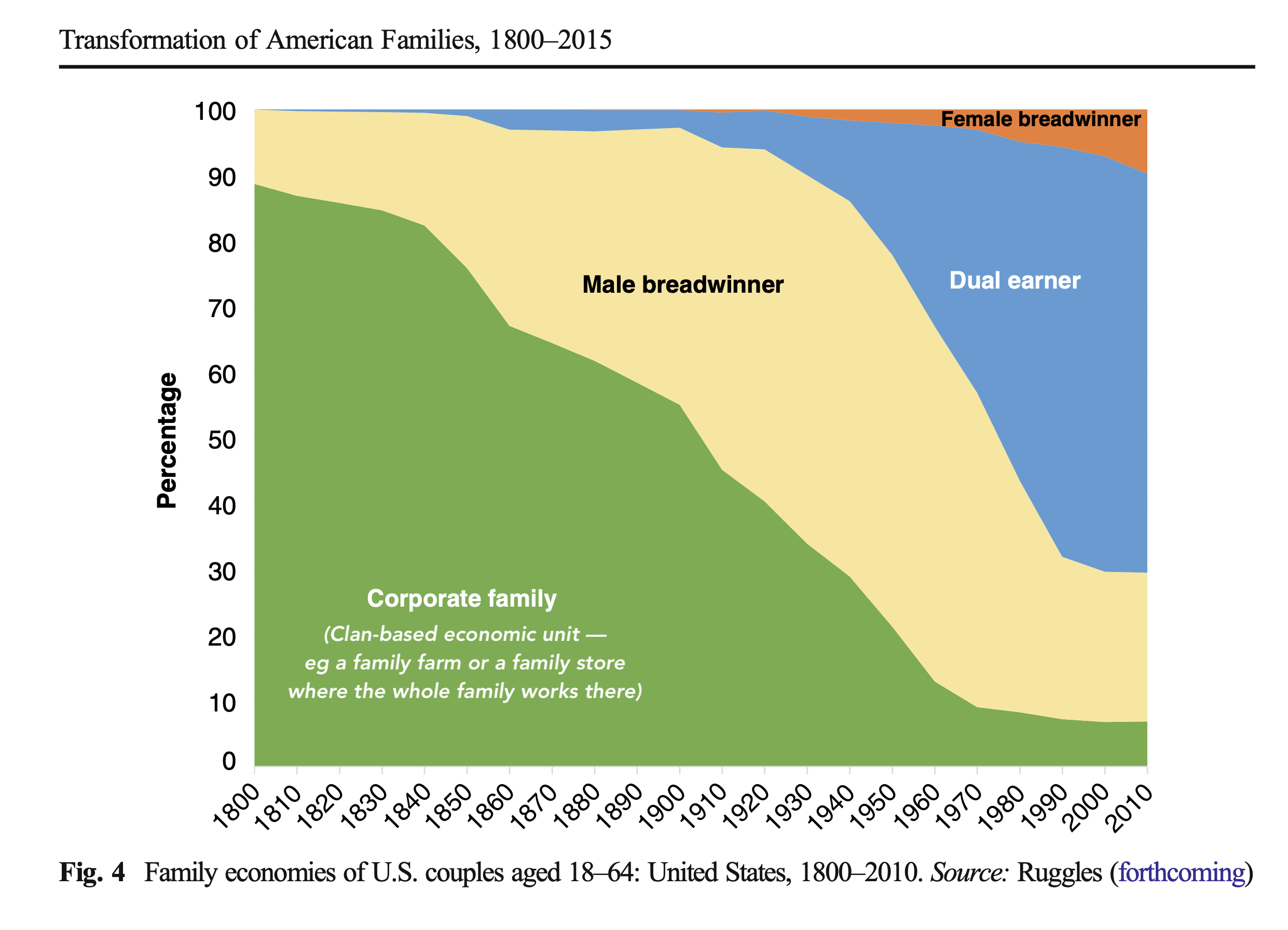
Wages, employment, and social roles are all in a shifting relationship with one another, and the equilibrium reached in one generation may not work or may no longer be desirable in another. In the late 1800s, the rapid rise of factory jobs destroyed the patriarchal and usually agrarian “family business”, giving young men much more power relative to their fathers, and helping create the “male breadwinner” family model that was common throughout the early to mid 1900s. Post-WWII economic conditions in the US caused a rapid growth in wages, which allowed young men entering the labor market to earn much higher salaries relative to their parents, and get married, buy a house, and have children much earlier. A tight labor market and social change around gender roles in the 1960s-1970s forced corporations to break their longstanding social norms about not hiring married women, which created far more dual-earning families, which enabled more gender equality.
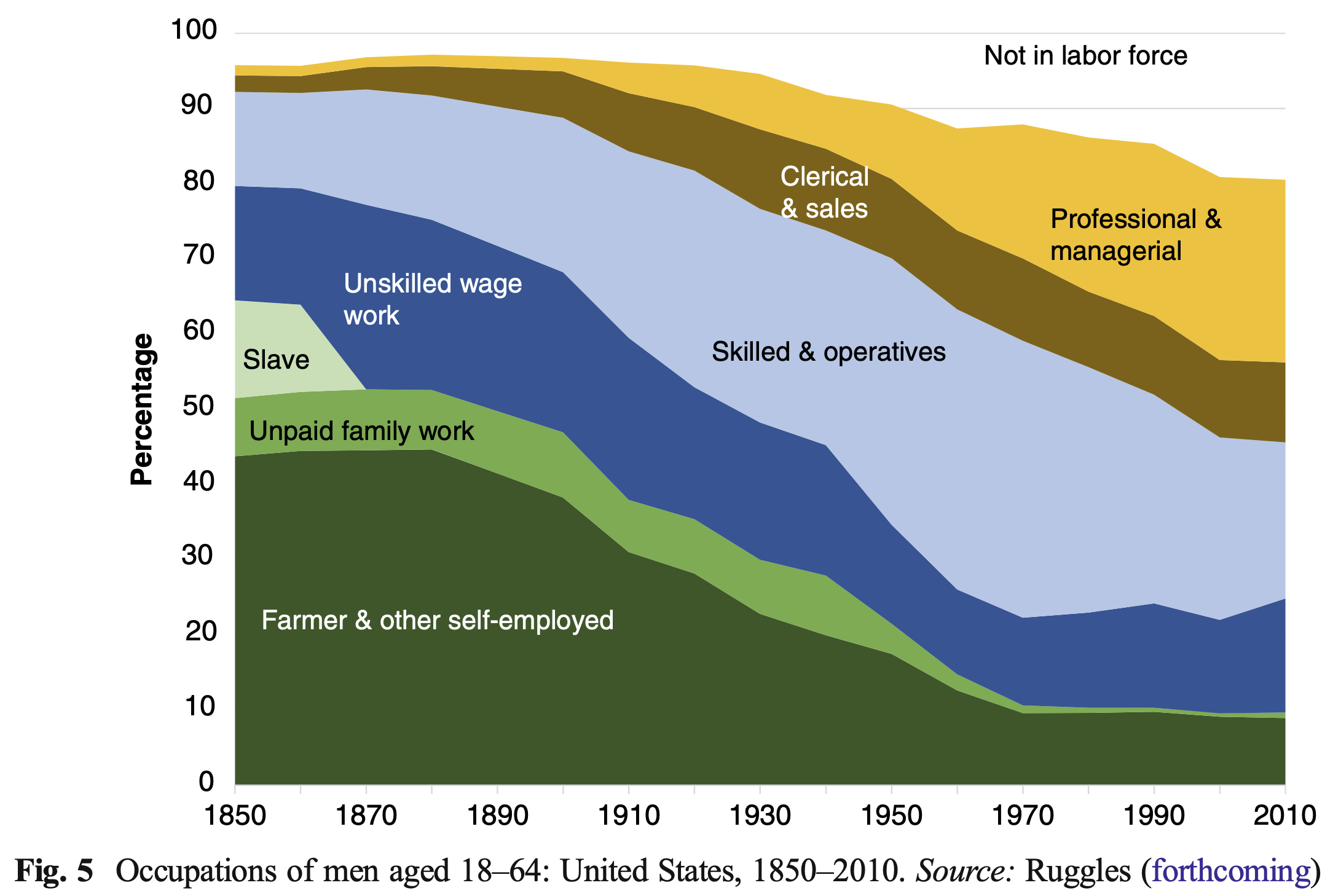
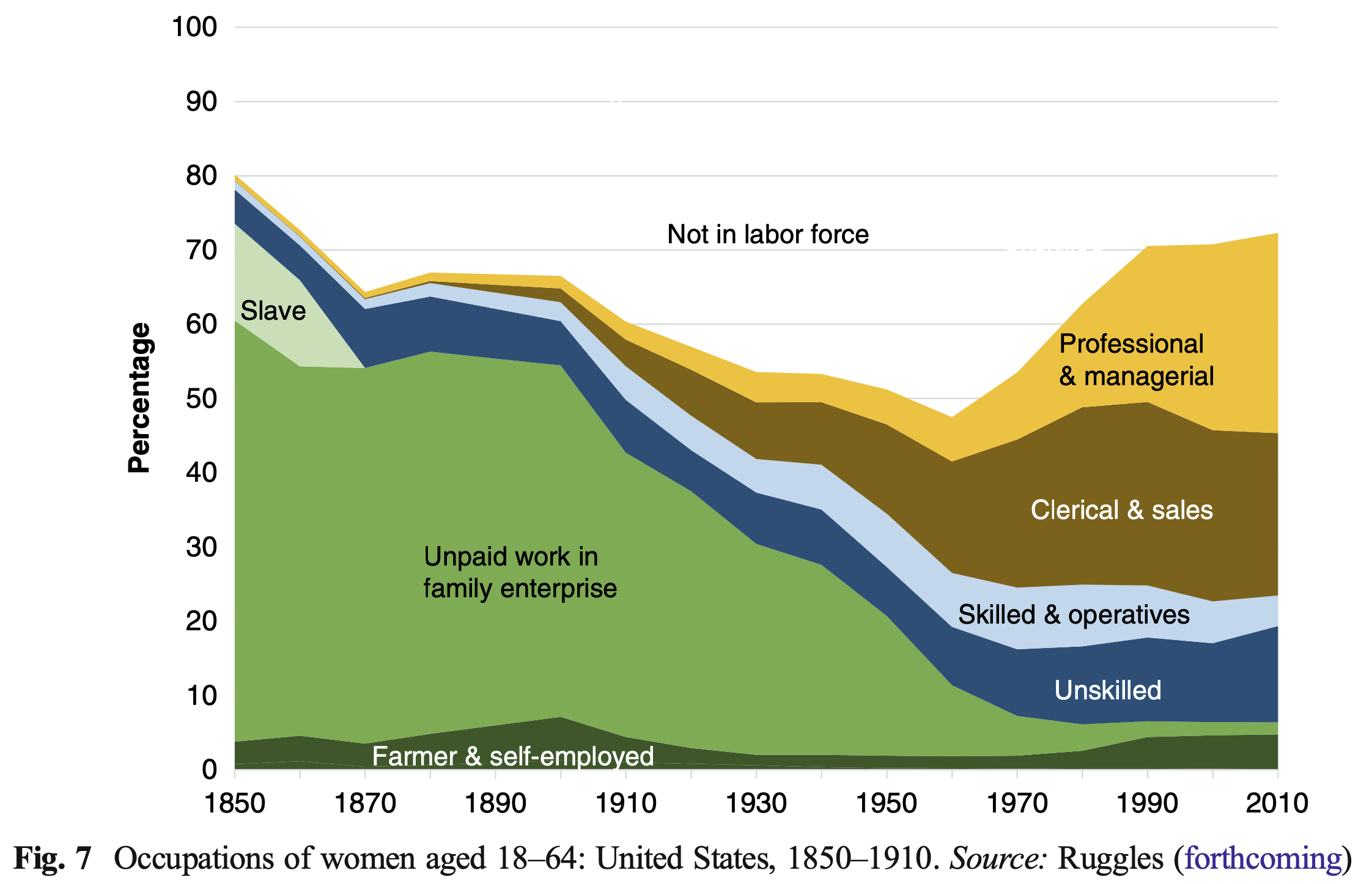
It's worth taking a specific look at the classic nuclear family as it is still very emblematic of an ideal that many people pursue. Young men entering the labor force in 1940s-1960s America had it really, really good. America was riding a multi-decade wave of rapid GDP growth brought on by industrialization and infrastructure improvements, much like China is today. Inflation-adjusted wages for workers under the age of 30 grew an astonishing 4x between 1940 and 1970. This enabled people to marry, buy homes, and start families early while enjoying a material abundance unknown to their parents’ generation. It enabled most young men to easily achieve a particular masculine role as "family provider", while most women were forced to accept a "homemaker" role. In part, this availability of well-paying jobs was also a special condition created by the aftermath of WWII, in which nearly the entire developed world, save for the US and Canada, had its industrial base devastated by war. America not only stayed intact, but also got to resupply and rebuild the rest of the world as well as become the world’s reserve currency, ensuring decades of financial control and dominance. Additionally, the nuclear family of the 1950s-1960s also existed in a culture that had a much stronger informal social safety net than exists today, with kids wandering from house to house, and neighbors taking up the slack when parents needed help caring for their kids.
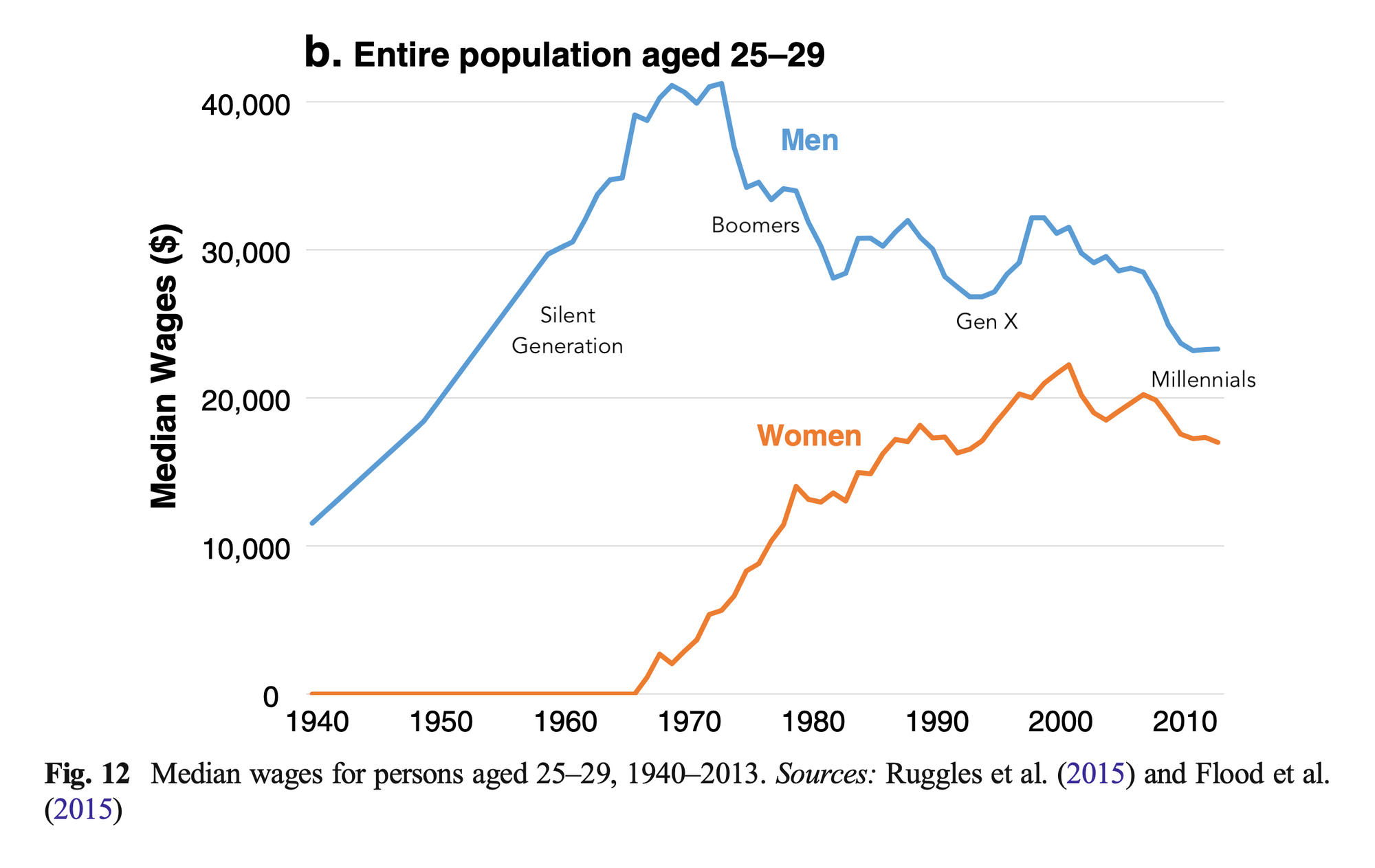
The job market has been harder ever since then, with the Silent Generation and Boomers complaining about young GenX'ers getting slow starts to their careers in the 1990s, and Boomers / older GenX’ers not comprehending why Millennials can’t afford houses in the 2010s. The reality is that the last two generations have simply had it worse than their parents from a wage perspective.

Income inequality has also increased since 1970, with younger workers experiencing much lower wages relative to the earning power of the top 1%. This manifests in a greater distance between the standard of living accessible to new people entering the workforce versus the standard of living of the well-off they see in the media.
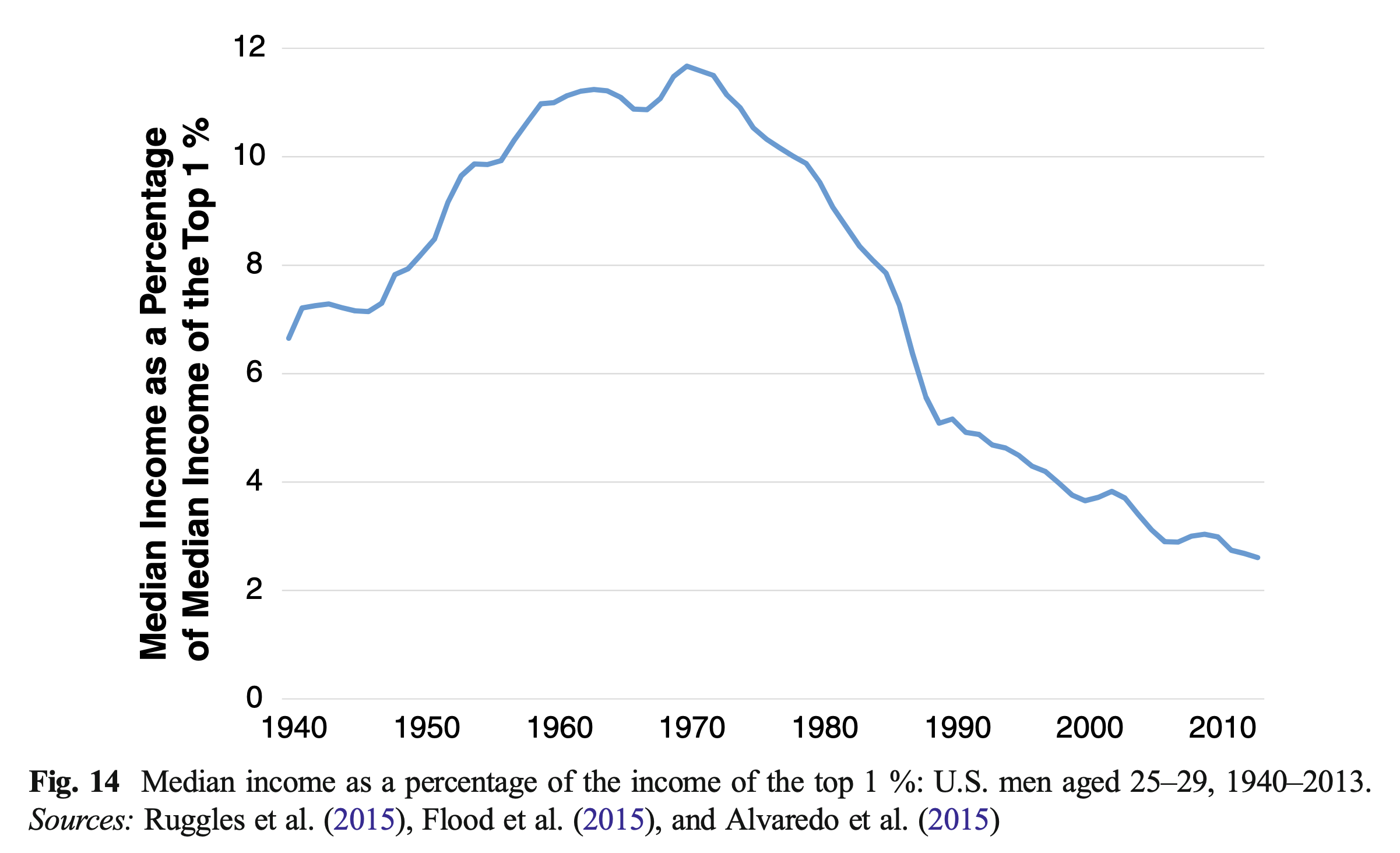
The decline in wages after 1970 has helped accelerate a shift to two-income families as well as likely drive a decrease in the number of children people are having. The dual-income nuclear family is great from a gender equality / leveled power dynamics perspective, but it presents challenges when kids are brought into the mix. Dual-income families tend to have substantially fewer children than single-income families. This is likely in part due to the career disruption that comes from having each kid, but it’s likely also partially due to difficulties in securing adequate childcare when both parents are working full time.

The relationship between income and fertility rate is complex, with wealthier people often having fewer children on average than less wealthy people. However, this is due in part to people of different incomes having different norms and expectations for standard of living and adequate childcare. People are generally having fewer children than they want to have, often for financial reasons. Increasing a family's income or decreasing their expenses will likely increase the number of kids they can afford at a given standard of living.
Increasing birthrate is also important because rapidly collapsing birthrates are bad for society. Population growth is a massive pyramid scheme whereby a larger group of working adults subsidizes a smaller group of retired older people. This pyramid scheme has been running so long that we've forgotten it exists. We’re seeing Japan deal with the serious effects of rapid population drop, in which the number of elderly is starting to approach the number of people of working age. The result is a government that is now so deeply in debt that it will almost certainly default at some point in the not-too-distant future. Obviously population cannot grow forever while we’re all stuck on the same planet with limited resources, but we also need to slow the population drop into more of a controlled landing than a collapse.
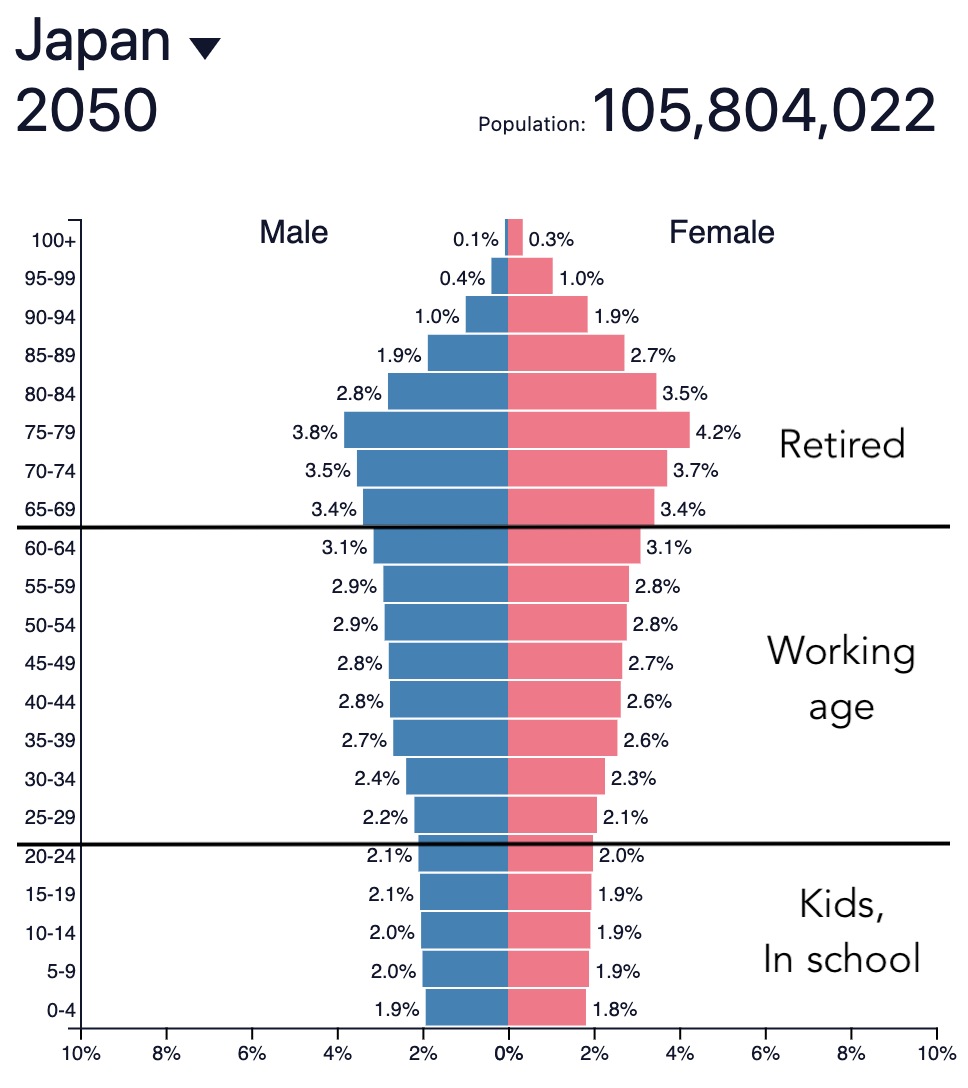
We’re dealing with a set of interrelated problems – outdated concepts of gender and family, declining birthrates, and stagnating wages.
What are the paths out of this? Complex problems require complex solutions, but here are some components of a solution:
We need to get spiraling costs in certain sectors under control
Capitalism is generally great at driving down the costs of most things over time, especially when coupled with technological progress. However, some very important things are getting drastically more expensive – housing, higher education, and healthcare – and these represent the main expenses in most people’s lives. The reasons for this are an essay in and of itself, but the main culprit in many cases is government interference and regulatory capture. Rising housing costs are due largely to artificial scarcity - a combination of exclusionary zoning, density limits, and overly burdensome permitting processes for construction. Rising healthcare costs are due to misaligned incentives between patients, doctors, pharma companies, and insurance companies that make healthcare spending inefficient and often ineffective, as well as an overly burdensome FDA approval process that increases the cost of drug development, makes it easier for pharma companies to price-gouge, and encourages corruption.
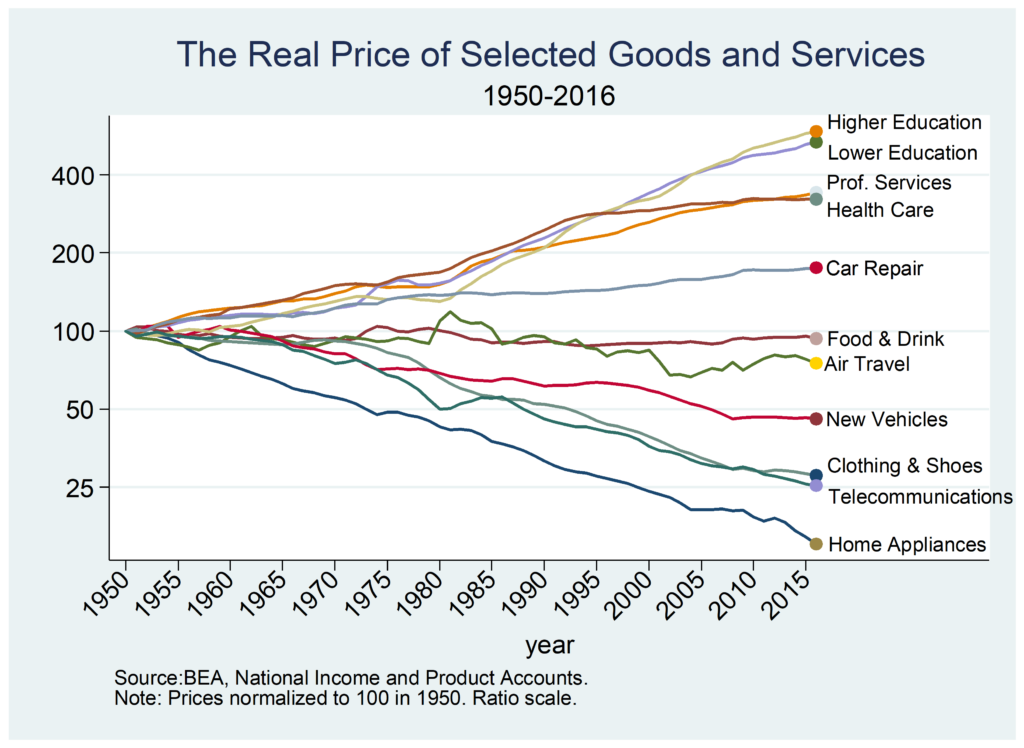
Driving down the costs of these things increases the real value of existing wages, enabling people to afford more on the same salary, which enables them to more freely choose a family structure that works for them and have more children if desired.
Organizations in the YIMBY movement are making slow but steady process on housing policy. There is discussion of student loan reform, but proposed solutions such as student loan forgiveness don’t address the problem that new student loans will continue to send millions into indentured servitude every year. I’m hoping that low cost alternate forms of higher education (trade schools, hybrid online-offline education etc) start to put competitive pressure on the university system. Reforming healthcare is extremely difficult given the degree of regulatory capture, but recently passed laws that increase billing transparency are a step in the right direction.
The government needs to make it easier for people to have kids
America’s social services are notoriously weak relative to the rest of the developed world. Parental leave is much shorter in the US than it is in Europe, and government-subsidized daycare options are limited. The US has a higher birthrate than Europe, but upon closer examination, the US’s birthrate is being very substantially boosted by immigrants. Without them, the US’s birthrate is as low as Europe’s. The preponderance of research suggests that increasing paid family leave appears to have a significant positive impact on fertility. Other effective options include increasing subsidies for daycare as well as direct cash subsidies to families for each kid they have. Note that these subsidies would help people have the number of kids they want to have but cannot currently afford.
Since it’s come up at a topic of discussion, banning abortion to deal with declining birthrates is just about the worst way to accomplish this, and it's unclear if it would even have the desired impact. Beyond the moral issue of forced pregnancy, removing women’s ability to control when and with whom they have children leads to trapping them in bad relationships, and forcing them to deal with unwanted babies ends up poorly for everyone – mother, baby, and society.
We need new positive social roles, especially for men
If current trends continue, the number of female-sole-breadwinner families may approach the number of male-sole-breadwinner families in the next 30-40 years. The portion of women drawing a salary is already about to surpass the portion of men drawing a salary. A significant portion of men have simply left the labor force with no plans to enter it again – 11% of men of prime working age 25-54 have given up on trying to find a job as of pre-pandemic 2020. Consequently, there need to be broadly socially acceptable roles for men other than sole or joint breadwinner.
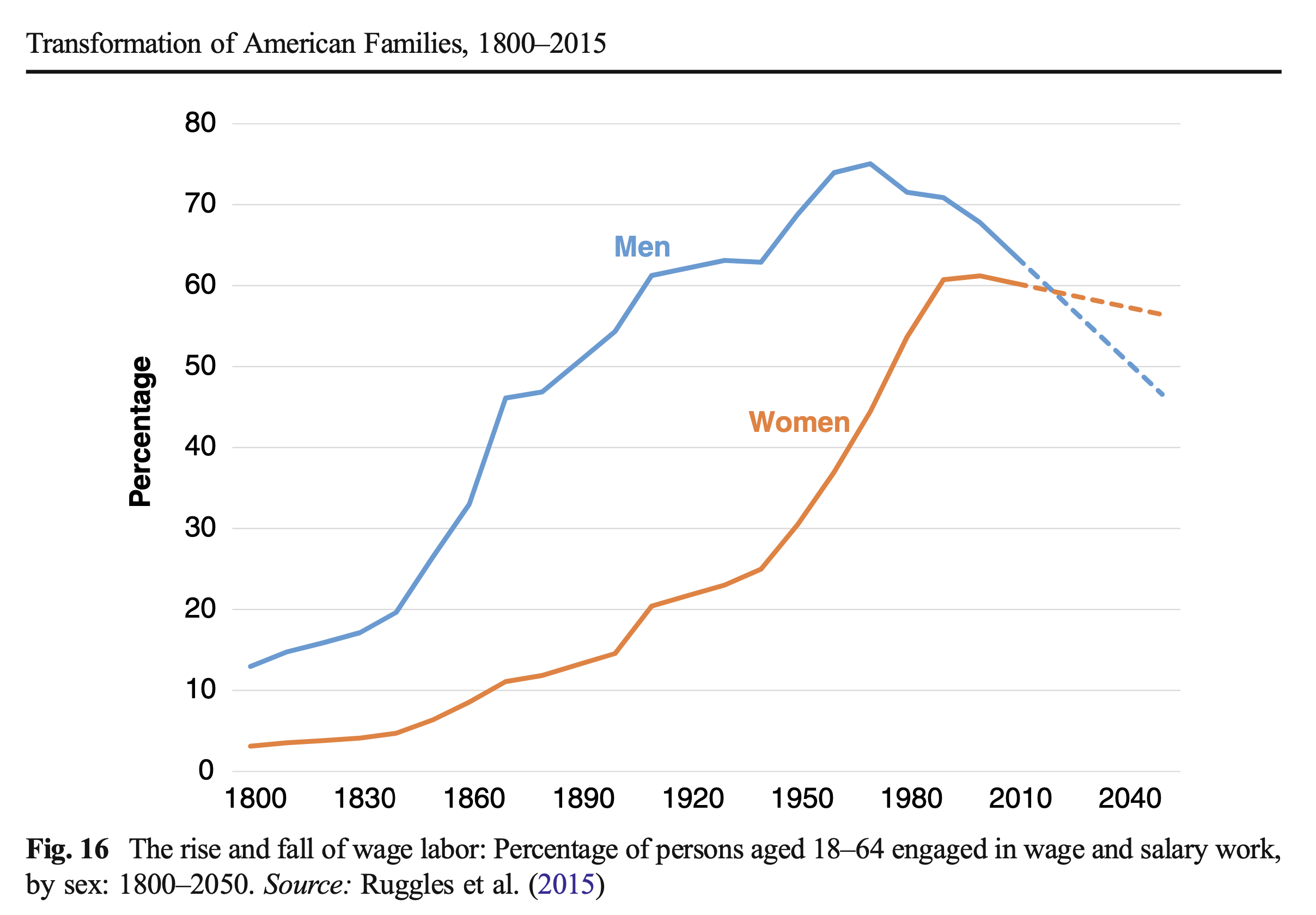
As Cathy Reisenwitz points out, there are currently very limited options for positively viewed social roles for men who aren’t breadwinners. Having positive role models for stay-at-home dads, or at least dads who do a bigger share of the housework and child-raising, is a step in that direction. I see early bits of this emerging with dad-influencers geeking out about the relative merits of different baby gear or posting viral videos about hijinks with their baby. A lot of it has a delightful "bro, imma show you how to up your stroller game" vibe that basically treats taking care of kids as just another skill young men should develop.
Separately, we need to normalize mid-life breaks for continuing education (as well as find ways of providing it at low or zero cost so that it's affordable for people to do so). Fields change, and new skills come into demand. It shouldn't be weird to be a 40-year-old student; it should be inspirational. This will help people who've given up on the labor market re-engage if they choose to do so by providing them with more marketable skills.
We need new definitions of family
Different people are going to want different types of families, and that’s OK. We can’t and shouldn’t want to replicate the certitude and default track of single-income nuclear families as they existed in the mid 1900s. We can take advantage of modern, more flexible social norms and gender roles to enable a wider range of options for everyone.
Some people will want to pursue nuclear families, and the other changes mentioned earlier in this list can help in that direction. Revisiting those structures:
Single-income nuclear families: Some people (regardless of gender) want to be able to spend a lot of or all of their time at home with their kids. It’s unlikely we’ll get to an economy in the short term that supports having broad adoption of single-income families like it did in the 1950s. However, with progress against housing, medical, and education expenses, we can potentially increase the number of families who can afford to go single-income over what it would have been otherwise, and that's still a net win as it's a family structure some people want. Furthermore, the expansion of flexible in-person and online gig work can create more part-time employment opportunities, which can enable parents to spend some time working while their kids are in school but be off early enough to pick them up afterwards.
Dual-income nuclear families: As discussed earlier, improvements in parental leave and government-subsidized early childcare would make it easier for two parents working full-time to raise kids.
However, there are some alternative family models (some of which are fairly normal in the rest of the world) that could help out with the current economic challenges of raising a family:
Multigenerational families: Re-integrating grandparents or other older relatives into the same household as the family is another option. This is fairly common in much of the world, especially Asia. Recently retired grandparents or other relatives from the previous generation can take on a large fraction of the childcare, enabling both parents to work without taking on too much expense in childcare. However, extended families are often broadly spread geographically, and many people are having kids too late for their parents to be of significant help. Changes in housing laws can help make this sort of multigenerational family easier. Currently, most houses are configured for nuclear families, with 2-4 bedrooms, but Accessory Dwelling Unit laws such as those passed in California recently make it easier to add an extra detached bedroom for the older relative to live in. Further changes to building codes and permitting processes can also smooth the process and lower the cost of expanding existing houses.
Multiple families living in the same house or adjacent condos: Cohousing with kids is becoming increasingly popular. Having other aligned and helpful parents nearby can help with child-raising tasks, making it easier to have kids. There are also beneficial economics to larger houses, enabling families to save money by living together. Families can also share nanny coverage. Finally, households with multiple families can create an atmosphere for kids that recreates some of the rich social experience of the 1950s-1960s, when kids were free to wander the neighborhood. While it’s often difficult to coordinate this type of co-living due to the scarcity of 5+ bedroom houses, there are groups making it happen.
Single parents living together: At this point, about 25% of American kids are in single-parent families, mostly with their mothers. Being a single parent is particularly difficult. Coliving can be helpful for single parents, as there are many tasks that are difficult to do while supervising a kid full-time, and the presence of a second adult to help watch the kids can be incredibly valuable. Multiple single parents can also share a nanny. This kind of living arrangement can also make it easier for single women who want to have children but have not found the right partner to contemplate doing so via sperm donor. There are now multiple sites that help connect single parents for coliving. I'd be excited for this kind of living situation to be normalized.
Master-planned kid-friendly neighborhoods: Corporate-run or co-op apartment buildings, condos, or mini-neighborhoods could be built that specifically cater to families by providing a broad range of integrated services, including on-site daycare and afternoon activities for different age groups, supervision of onsite play areas, meal preparation, and other amenities. Kids could run freely anywhere on the property without parental supervision. Projects like these would be large enough to be integrated into local school bus routes, or might even contain primary schools onsite. This centralization would enable families to attain a given standard of living while spending less money and time making it all happen. The start-up costs of this kind of project are obviously high, and there are the inevitable social conflicts that come from such a large interdependent system, but it seems like a direction that's worth experimenting with.
Further reading
If you're interested in some more detailed treatments of the topic of American family structures over time and present challenges, check out:
- The Nuclear Family was a Mistake, by David Brooks, which got me curious to dive deeper into the topic and caused me to end up writing this post. There have been plenty of "nuclear family bad" articles, but this one actually taught me a lot.
- Patriarchy, Power, and Pay: The Transformation of American Families, 1800–2015 – many of the graphs in this post are from this paper.
